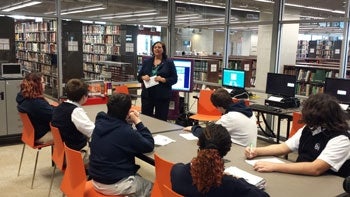Social Networking and Libraries
By Sara Rodriguez
In an age where social media has become a big part of people's everyday, it is no question why libraries have used platforms such as Twitter, Facebook, Youtube, Google+, Tumblr and other platforms to provide services. This is a way for libraries to expand their resources and services outside of their library and on to the online community.
There has been an emphasis on social networking by libraries. This is seen in a survey done by the Library’s Journal, where 86% of libraries admitted to implementing social media in their environment. Most of these libraries use sites such as facebook and twitter to reach out to patrons. I feel this is a good start for libraries as these social media sites are used daily by individuals, thus making it easier for libraries to create online communities with patrons
In the article Library Technology Reports by Griffey, it claims that social networking has led to some issues regarding privacy policy, which libraries are notoriously known for. The main issue for here is that social networking is useful when you make an identity online thus letting people know who you are. Libraries for so long though have valued their patrons privacy and believe that knowing who you are and what you like is something that should be kept to yourself. This is strictly stated in the The American Library Association’s Code of Ethics “We protect each library user’s right to privacy and confidentiality with respect to information sought or received and resources consulted, borrowed, acquired or transmitted.” It's the 21st and times have changed, now when patrons access social media through libraries it makes it harder for libraries to protect their privacy. A recent survey showed that 72% of libraries have no social media policy in place. This obviously can even lead to serious online threats such as bullying and peer pressure for young adults, i can see this being a bad thing because now children can face danger in a library, which for many years has a reputation of being a “safe” environment . That said social networking and libraries has not been a completely negative thing as their has many benefits from this 21st century transformation.
One benefit the use of social networking can bring is the ability to communicate with patrons about library events. This is a way for patrons to find out more about library events and get more involved with the community. The San Diego Library for instance notifies patrons of new book arrivals, volunteer opportunities, and competitions that are going on. This is a good strategy to inform patrons as well as bring in new patrons. We are living In a time where everyone is or has used some type of social media, which is why I feel like the use of social media by libraries can bring many benefits to the community.
Resources:
American Library Association, Library Bill of Rights, adopted June 19, 1939; amended Oct. 14, 1944; June 18, 1948; Feb. 2, 1961; June 27, 1967; and Jan. 23, 1980;
Griffey, J. (2010). Chapter 5: Social Networking and the Library. Library Technology Reports, 46(8), 34-37.
5 ways libraries are using social media. (2016, February 24). Retrieved April 27, 2017, from
"Social Media: Libraries Are Posting, but Is Anyone Listening?" Library Journal. N.p., n.d. Web. 27 Apr. 2017





/about/iphone-sms-mms-5804f1155f9b5805c2c32e59.jpg)
